<<PREVIOUS -
HOME -
CONTENTS -
NEXT>>
ASTROIMAGING - ITS
![]()
Imaging The Sky 2002 Conference
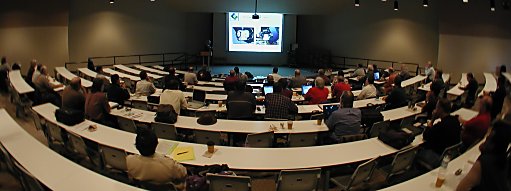
<<PREVIOUS -
HOME -
CONTENTS -
NEXT>>
ASTROIMAGING - ITS
![]()

The Imaging The Sky 2002 Conference was held on November 8 Ė 9, 2002 in Salem, Oregon, USA. The conference had attendance of over 60 attendees from Oregon, Washington, California, Canada, New York and other states. Mel Bartels, Richard Berry, Jim Girard, David Haworth, Rick Kang and Nick Liepins organized the conference. Imaging The Sky 2002 Conference schedule PDF file 14 KB.
I think this year's was the best so far. There was something for beginners and advanced. The presentations all had something of added value. George LaBelle
It really was the best ITS ever. There were a lot of practical "how to" sessions that I think everyone was able to get something out of. Everyone was willing to share ideas and software with the imaging community. As usual, it inspired me to get out and do some more imaging. Now, if the weather would just cooperate... Dave Sandage
Burnell's, Boltwood's, and Zerbe's stuff really opened eyes. Mel Bartels
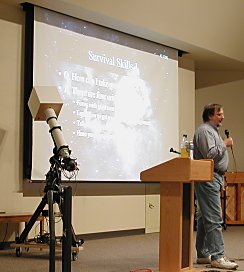 Ron Wodaski
presented CCD imaging fundamentals and CCD imaging applications that included
measuring position (astrometry), measuring brightness (photometry, light curves) and producing
beautiful images. Ron gave an overview of a CCD imaging setup that included the mount, optics,
camera and accessories. Next, Ron described typical CCD imaging activities in an imaging session;
image calibration (showing the before and after affects of calibration) and the enhancements that
can be obtain with image processing. Additional CCD information resources were reviewed at the session end.
Ron Wodaski
presented CCD imaging fundamentals and CCD imaging applications that included
measuring position (astrometry), measuring brightness (photometry, light curves) and producing
beautiful images. Ron gave an overview of a CCD imaging setup that included the mount, optics,
camera and accessories. Next, Ron described typical CCD imaging activities in an imaging session;
image calibration (showing the before and after affects of calibration) and the enhancements that
can be obtain with image processing. Additional CCD information resources were reviewed at the session end.
For the session Jim Girard setup his imaging telescope: Tak FS-102 telescope, ST-8e w/CFW8 CCD camera, homemade optocoupler and a G-11/Gemini mount with wheelie bar.
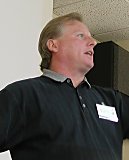 Dave Kenyon
presented practical astronomical photometry. This included definition of
photometry, its history, advantages of using a CCD camera for photometry, how to match
the camera to the telescope, the need for good SNR, imaging software tools used, and the
importance of using the correct filters. Dave gave an example of a photometric run and
showed how to use differential photometry used for stellar photometry, asteroid photometry
and comet photometry. Next all sky photometry was described. The session ended with how to
submit photometry data. Also, Dave provided Practical Astronomy Photometry handbooks at the end of the session.
Dave Kenyon
presented practical astronomical photometry. This included definition of
photometry, its history, advantages of using a CCD camera for photometry, how to match
the camera to the telescope, the need for good SNR, imaging software tools used, and the
importance of using the correct filters. Dave gave an example of a photometric run and
showed how to use differential photometry used for stellar photometry, asteroid photometry
and comet photometry. Next all sky photometry was described. The session ended with how to
submit photometry data. Also, Dave provided Practical Astronomy Photometry handbooks at the end of the session.
Lew Cook presented a CCD imaging photometry application covering the outbursts of WZ Sge during 2001. WZ Sge is a known binary with a period of 81.6 minutes and there was a need for continuous (24 hour a day, 7 days per week) coverage of the light curve with high-speed photometry. Lew was part of a worldwide group of mostly amateurs with CCD cameras and small telescopes that gathered an extensive series of observations. Lew used AIP4WIN for photometry.
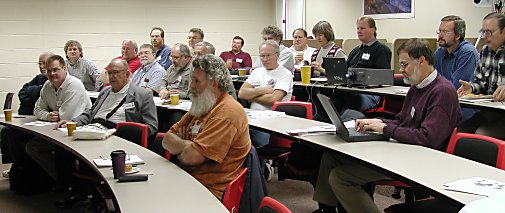
The WZ Sge light curves were obtained every night from the first day of the outburst until the 86th night. The outburst began with orbital superhumps of decreasing amplitude. On the 13th day common superhumps started and lasted through the 53-day outburst and another 60 days beyond. These photometry observations were combined into a set of data that allowed for many features of WZ Sge to be determined from the variations in the light curve. For more details download the "The 2001 Superoutburst of WZ Sagittae" paper.
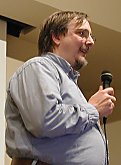 Ron Wodaski
presented a zones imaging processing technique. Ron defined five zones
with each with a different image processing strategy. The first zone is the dark zone
that is below the black point and processing technique is to eliminate it. The second
zone is the dim zone that is the darkest details you want to reveal and processing technique
is to smooth the zone. The third zone is the middle zone that is the bulk of the data and
typically is histogram processed only. Last is the bright zone with high signal to noise
ratio (SNR) that has stars, galaxy cores and bright nebulosity. The bright zone is sharpen.
Examples images taken from his front yard in suburbs were shown using PhotoShop curves features.
Ron Wodaski
presented a zones imaging processing technique. Ron defined five zones
with each with a different image processing strategy. The first zone is the dark zone
that is below the black point and processing technique is to eliminate it. The second
zone is the dim zone that is the darkest details you want to reveal and processing technique
is to smooth the zone. The third zone is the middle zone that is the bulk of the data and
typically is histogram processed only. Last is the bright zone with high signal to noise
ratio (SNR) that has stars, galaxy cores and bright nebulosity. The bright zone is sharpen.
Examples images taken from his front yard in suburbs were shown using PhotoShop curves features.
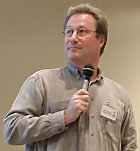 Don Goldman
presented the problems with getting true colors from RGB filters.
Color is important in that it provides a way to explain the physics and history
of galaxies and stars. Don showed the cross over problems with RBG Filters and
OIII emissions. The color imaging paradox is that the colors of stars are broadband
and the colors of nebulae are narrowband. Don explained the complex interaction of
the CCD camera QE, several types of RGB filter sets and atmospheric extinction.
This interaction determines the image time ratios for the filter set for a specific
camera and object altitude. Don proposed RGBO technique to solve the broadband and
narrowband paradox. Also, Don demonstrated a RGB Weight Calculator for astrophotography
that he developed.
Don Goldman
presented the problems with getting true colors from RGB filters.
Color is important in that it provides a way to explain the physics and history
of galaxies and stars. Don showed the cross over problems with RBG Filters and
OIII emissions. The color imaging paradox is that the colors of stars are broadband
and the colors of nebulae are narrowband. Don explained the complex interaction of
the CCD camera QE, several types of RGB filter sets and atmospheric extinction.
This interaction determines the image time ratios for the filter set for a specific
camera and object altitude. Don proposed RGBO technique to solve the broadband and
narrowband paradox. Also, Don demonstrated a RGB Weight Calculator for astrophotography
that he developed.
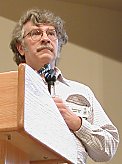 Richard Berry
presented why CCD cameras are great for imaging, the
Poisson distribution theory and the affects of noise, the examples of
increasing the signal to noise ratio, noise in bias, darks and flats
and how to build good urban images. The signal to noise ratio (SNR) is
the ratio between the useful signal and the noise. When the SNR is low
the image (signal) gets lost in the noise. The goal is to increase the
SNR so that the image stands out from the noise. Urban imaging is possible
by increasing the SNR of an image by taking longer images or/and stacking
multiple different images. Also, Richard demonstrated a SNRs for CCDs
Calculator that he developed.
Richard Berry
presented why CCD cameras are great for imaging, the
Poisson distribution theory and the affects of noise, the examples of
increasing the signal to noise ratio, noise in bias, darks and flats
and how to build good urban images. The signal to noise ratio (SNR) is
the ratio between the useful signal and the noise. When the SNR is low
the image (signal) gets lost in the noise. The goal is to increase the
SNR so that the image stands out from the noise. Urban imaging is possible
by increasing the SNR of an image by taking longer images or/and stacking
multiple different images. Also, Richard demonstrated a SNRs for CCDs
Calculator that he developed.
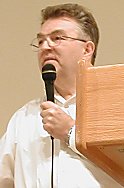 Paul Boltwood
won the Sky and Telescope deep field contest with an image that reached magnitude of 24.1.
Paul accomplished this in suburban skies and using a CCD camera with 40% QE on a 16-inch telescope.
Paulís motivating force is to try to do everything right. Most of Paulís equipment and software is homemade.
Paul built a roll off roof observatory with a telescope room and equipment room.
Paul described his homemade telescope, focuser, TH7883 camera, filter wheel, flat field light
source, telescope control software, database software, and reduction software. Paul says the
number one problem with faint target urban imaging is to flatten the sky background.
Paul usually takes multiple two-minute images and stacks them. Also, Paul described his
polar alignment process for German equatorial mounts.
Paul Boltwood
won the Sky and Telescope deep field contest with an image that reached magnitude of 24.1.
Paul accomplished this in suburban skies and using a CCD camera with 40% QE on a 16-inch telescope.
Paulís motivating force is to try to do everything right. Most of Paulís equipment and software is homemade.
Paul built a roll off roof observatory with a telescope room and equipment room.
Paul described his homemade telescope, focuser, TH7883 camera, filter wheel, flat field light
source, telescope control software, database software, and reduction software. Paul says the
number one problem with faint target urban imaging is to flatten the sky background.
Paul usually takes multiple two-minute images and stacks them. Also, Paul described his
polar alignment process for German equatorial mounts.
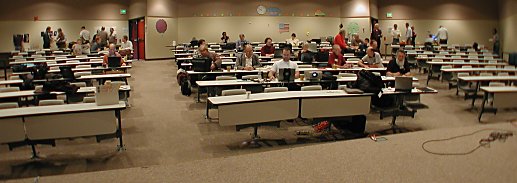
Saturday morning started off with coffee, juice and donuts. Session breaks provided time to further explore CCD imaging techniques with the presenters and other attendees. Saturday morning coffee, juice, donuts, lunch and dinner was included in the conference registration fee.
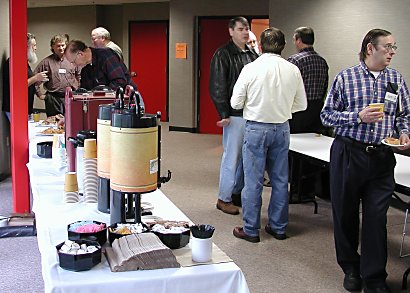
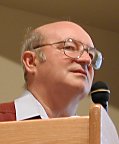 Morley Blouke, Scientific Imaging Technologies
Morley Blouke presented new CCD technologies that are under development by various organizations around the world.
One CCD device is being designed to count single photons. Another CCD device is an orthogonal parallel
transfer-imaging camera that improves the FWHM by 33% by tracking the seeing motion of a star.
Also, large infrared CCDs are under development that will be used in the Next Generation Space Telescope (NGST).
Morley Blouke, Scientific Imaging Technologies
Morley Blouke presented new CCD technologies that are under development by various organizations around the world.
One CCD device is being designed to count single photons. Another CCD device is an orthogonal parallel
transfer-imaging camera that improves the FWHM by 33% by tracking the seeing motion of a star.
Also, large infrared CCDs are under development that will be used in the Next Generation Space Telescope (NGST).
Tom Carrico presented techniques on how to obtain small round stars. Tom showed how to measure how round a star is with various imaging software. A well-formed star will have the best (lowest) possible FWHM for the seeing conditions. Its elongation/flatness will approach zero. Tom described optimizing the telescope mount and guiding. The basic assumptions for good guiding include the object and guider are focused, polar alignment is good, the object is high above horizon and the mount is sound. Tomís Theorem: the mount that is guided least is guided best. Also, Tomís soap box: if it cannot be measured it cannot be known. Tom covered in detail the calibration steps on a G-11 mount. These steps included minimum move, guide interval exposure, calibration setting and delay after correction. Some of Tomís tips include balance wisely, great polar alignment helps Dec, disable one direction of Dec and manage your cables. Also, Tom demonstrated a guiding charting tool that he developed. The software will be completed in late December.
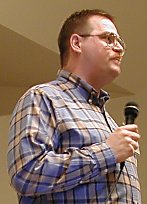 Jim Burnell's
observatory is 44 miles from the center of Manhattan.
Jim showed how successful he has been in imaging faint galaxies and galaxy clusters with a 5 inch f/6 refractor.
Jim demonstrated the affects of a properly exposed star the full well capacity of a CCD camera.
Jim showed a very nice example of increasing the SNR of NGC 253 (low over Manhattan sky glow) by taking multiple exposures.
The key is stacking improves SNR. Jim showed numerous examples of galaxy cluster that
included M84/86, M100, NGC 7331, Stephanís Quintet, Coma cluster, Hercules Galaxy cluster,
Abell 2152, Corona Borealis cluster, and Abell 2199. Jim showed several examples of color imaging.
Jim tips include baffle the scope to remove scattered light, make good dark and flat frames,
short exposures, stack large numbers of images to obtain high SNR
Jim Burnell's
observatory is 44 miles from the center of Manhattan.
Jim showed how successful he has been in imaging faint galaxies and galaxy clusters with a 5 inch f/6 refractor.
Jim demonstrated the affects of a properly exposed star the full well capacity of a CCD camera.
Jim showed a very nice example of increasing the SNR of NGC 253 (low over Manhattan sky glow) by taking multiple exposures.
The key is stacking improves SNR. Jim showed numerous examples of galaxy cluster that
included M84/86, M100, NGC 7331, Stephanís Quintet, Coma cluster, Hercules Galaxy cluster,
Abell 2152, Corona Borealis cluster, and Abell 2199. Jim showed several examples of color imaging.
Jim tips include baffle the scope to remove scattered light, make good dark and flat frames,
short exposures, stack large numbers of images to obtain high SNR
Doug George, Diffraction Limited describe the challenge of taking over 20,000 images over several years and two locations to create a pole to pole color CCD mosaic of the entire sky. An AP9e with special lens and mount was design for this project. The images are 12-arc seconds/pixel and are feather with 10 % overlap. The mosaic is part of the full-featured planetarium software call the Desktop Universe. Check www.desktopuniverse.com for details and demos.
Richard Berry and Jim Burnell demonstrated image calibration (bias, darks and flats) and stacking images using AIP4WIN.
Ron Wodaski presented three programming options: scripts, programs and plug-ins. Scripts are easy to write/edit, but lack flexibility. Programs require more effort to write, but are more flexible than scripts. A plug-ins is a program design to work with a specific program. Ron presented examples of Scripts, VB Programs and a MaxIm DL Histogrammer plug-in. Also, Ron covered basic language concepts such as objects, methods and properties.
Craig Zerbe presented the advantages and disadvantages of video astronomy. Advantages include images 30 frames per second; inexpensive compared to CCD, easy to focus, easy target acquisition, instant gratification and collecting lots of images fast (30 images per second). Disadvantages include small field of view, poor SNR, typically 8 bits, interlaced video and limited exposure times. Craig showed examples of high-resolution images of the moon, sun and planets. Some of the moon images were mosaics. Craig;s tips include long focal lengths (8400 mm) to image small details and intelligently stack lots (sometimes over 100) of images to obtain high SNR. Free Registax software is a key tool to intelligently stacking images and image processing is done by a wavelet process on the stacked image.
Wayne Brown went over the history and discussed the future directions of Apogee Instruments. Apogee Instruments provides CCD cameras for a variety of scientific uses that include mid-range to high-end cameras for astronomy.
The conference ended with a group dinner and late evening discussions
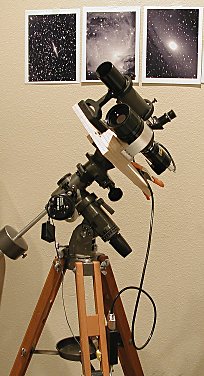
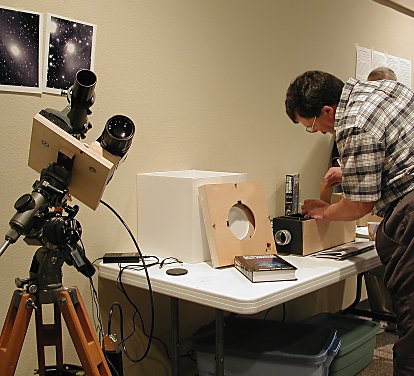
Richard Berry CCD Camera Setup, Light Box and Low Level Light Source
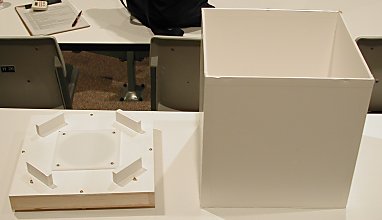
Jim Girard Light Box
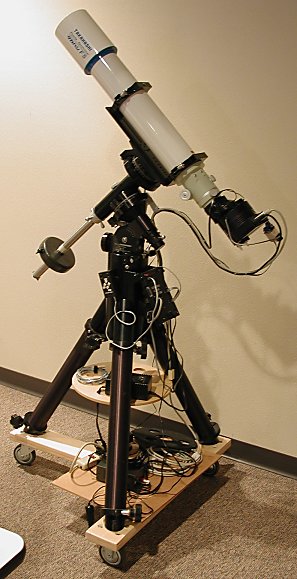
Jim Girard Tak FS-102 telescope, ST-8e w/CFW8 CCD camera,
homemade optocoupler and a G-11/Gemini mount with wheelie bar.
A Image the Sky 2002 Presentations CD-ROM and a CCD imaging freeware, trial and demo software CD-ROM were given to each conference attendee.

|
Conference Location |